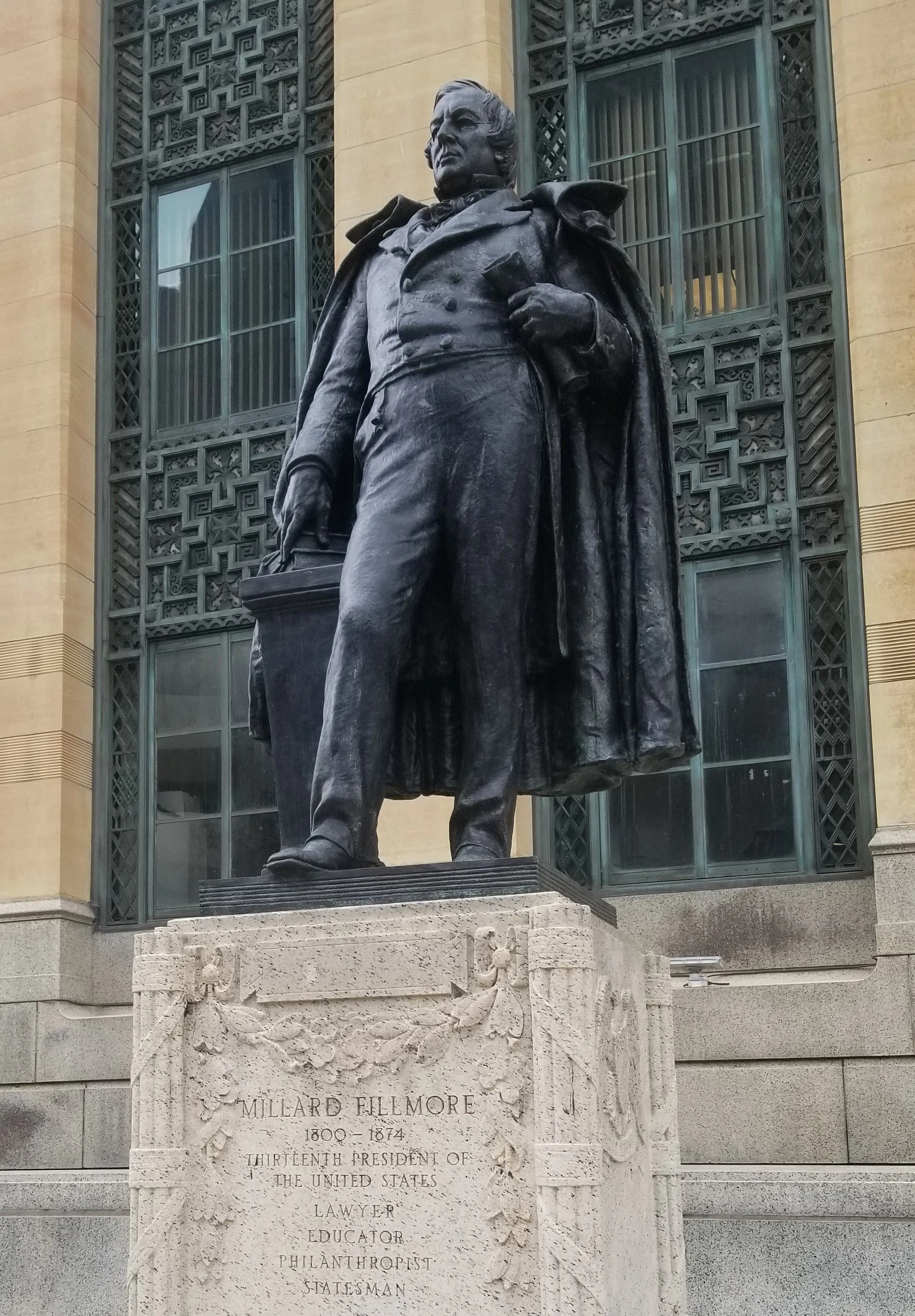Local governments in New York State are required to follow a 410-page document, known as the Local Government Schedule or LGS-1, to determine how long their records must be kept. The cover of LGS-1’s 2022 edition uses a photo of Buffalo’s City Hall to complement its Art Deco styling, yet it’s apparent that Buffalo's municipal government struggles to comply with the records retention schedule contained therein.
Buffalo City Hall is flanked on one side by a statue of the thirteenth U.S. President, Millard Fillmore, who practiced law in Buffalo and represented the city in the U.S. House of Representatives between 1837 and 1843. A bust of President Fillmore next to City Hall’s directory (which currently names a City Clerk who left office in 2019) greets visitors and employees after they pass through security at the building’s main entrance.
Buffalo City Hall’s Millard Fillmore statue, photo by Nathan Feist (CC BY-SA 4.0)
Buffalo City Hall’s bust of Millard Fillmore, photo by Nathan Feist (CC BY-SA 4.0)
President Fillmore signed into law the Fugitive Slave Act of 1850, which was condemned across northern states (where slavery was by then illegal) because it required law enforcement officers to arrest anyone alleged to be an escaped slave, imposed fines of $1,000 dollars (over $38,000 in today’s dollars) on officers who did not effect arrest and on civilians who allegedly aided fugitives, and rewarded officers and judges who arrested and convicted those alleged to be escaped slaves.
With this sordid history in mind, Buffalo’s legislative body—the Buffalo Common Council—unanimously adopted a resolution “to establish a poll on what City-owned property that bears the name Fillmore should be changed and what new name should take its place.” The Common Council posted a questionnaire on Facebook a week later, and The Buffalo News encouraged the public to also provide responses by phone and e-mail.
The Common Council’s Facebook post announcing its Millard Fillmore survey
The results of this survey have never been published, and, in response to a Freedom of Information Law request, the City Clerk stated that the results of the Common Council’s questionnaire are not available because they are located only on a personal account of a former employee.
The LGS-1, meanwhile, sets a 6-year retention period for opinion survey results and directs appraising said records for historical significance so that survey results “involving very significant issues” are retained permanently.
In response to my request for all results from the survey, the City Clerk was able to provide one e-mail from a member of the public, who wrote that renaming Fillmore Avenue “is an outstanding opportunity to affect public trust of local government,” noted that the 1850 Fugitive Slave Act allowed free Blacks to be kidnapped and sold in the South, and recommended that the avenue be renamed Juneteenth Avenue. Buffalo’s annual Juneteenth parade proceeds up Fillmore Avenue to Martin Luther King, Jr. Park.
MLK Park was once a park called “The Parade.” Fillmore Avenue now bisects it.
Fillmore Avenue was last renamed in the mid-1870s (President Fillmore died in 1874). An 1872 map of Buffalo labels the portion north of what is now MLK Park “Walden” and labels the portion south of the park “Adams St.” Another 1872 map labels the south portion “East Street.” An 1866 map (before the park was constructed) labels the entire street as Walden Street.
The first judge of the Erie County Court and eighth mayor of Buffalo, Ebenezer Walden, owned a large plot of land there, and until 1969, the Common Council’s Fillmore District was named Walden District.
Augustyn “Gus” Franczyk represented Buffalo’s Walden District in 1968
In October 2020, the Common Council unanimously approved a resolution to designate Fillmore Avenue “Black Lives Matter Way” and cited a teenager named Mekhi Edwards who recommended in June 2020 that a Buffalo street be painted with the phrase Black Lives Matter (Washington, D.C. did this the day it designated two of its city blocks as Black Lives Matter Plaza). Council members pledged to install trailblazing signs on Fillmore Avenue with the new designation, and Mayor Byron Brown directed that the signs be installed in an “expedited manner so that residents can appreciate this historic moment as quickly as possible.”
As of March 2023, no such signs are present, and the Common Council appears to have deleted its Facebook post announcing the change (a record of that post is preserved in a WIVB News article). The LGS-1 specifies that public relations communications containing “significant information” be retained permanently.
Fillmore Avenue at Broadway in September 2022, adapted from work of Andre Carrotflower (CC BY-SA 4.0)
Public figures who embraced slavery remain the namesakes of streets in many Buffalo neighborhoods. Washington Street is named for a U.S. president who ratified the Fugitive Slave Act of 1793 and owned 123 slaves at the time of his death. Jefferson Avenue’s presidential namesake pursued abolition of slavery but owned 600 slaves over the course of his life and freed very few. Porter Avenue and Breckenridge Street are named after perhaps the first slaveholders to live in Buffalo. In 1820, General Peter Buell Porter and his wife Letitia Breckenridge brought five young slaves to Buffalo, where the slaves were considered indentured servants under a New York State law that required they be freed at 28 years of age for men and 25 years of age for women.
Spurred by the racial justice protests of 2020, the University at Buffalo and Buffalo State have renamed their buildings and facilities previously named after General Porter and President Fillmore. There may be majority support among residents of the City of Buffalo to remove those names from municipal property, but nearly no records of the Buffalo Common Council’s public opinion survey on this subject are available to the taxpayers who funded the survey, because City Hall is apparently not in compliance with the New York State retention schedule that bears its image, LGS-1.






